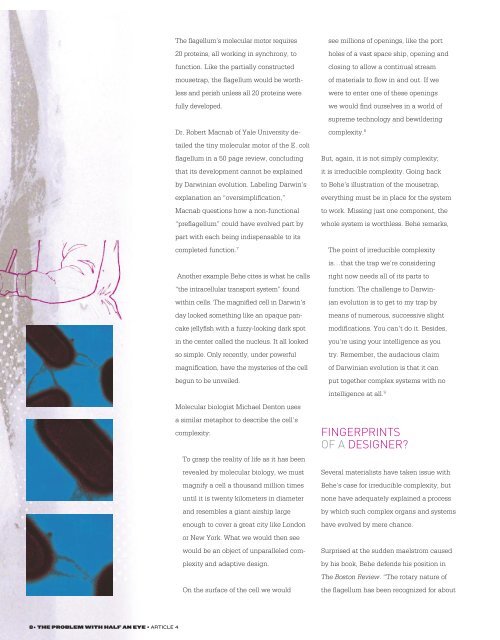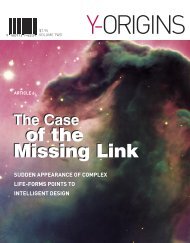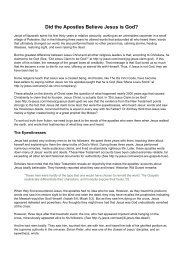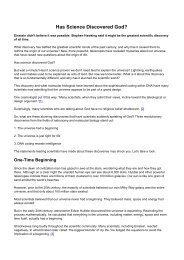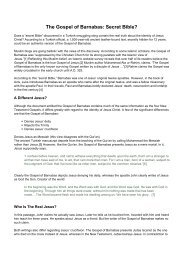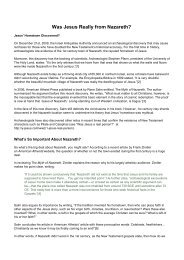half_an_eye4
Create successful ePaper yourself
Turn your PDF publications into a flip-book with our unique Google optimized e-Paper software.
The flagellum’s molecular motor requires<br />
20 proteins, all working in synchrony, to<br />
function. Like the partially constructed<br />
mousetrap, the flagellum would be worthless<br />
<strong>an</strong>d perish unless all 20 proteins were<br />
fully developed.<br />
Dr. Robert Macnab of Yale University detailed<br />
the tiny molecular motor of the E. coli<br />
flagellum in a 50 page review, concluding<br />
that its development c<strong>an</strong>not be explained<br />
by Darwini<strong>an</strong> evolution. Labeling Darwin’s<br />
expl<strong>an</strong>ation <strong>an</strong> “oversimplification,”<br />
Macnab questions how a non-functional<br />
“preflagellum” could have evolved part by<br />
part with each being indispensable to its<br />
completed function. 7<br />
Another example Behe cites is what he calls<br />
“the intracellular tr<strong>an</strong>sport system” found<br />
within cells. The magnified cell in Darwin’s<br />
day looked something like <strong>an</strong> opaque p<strong>an</strong>cake<br />
jellyfish with a fuzzy-looking dark spot<br />
in the center called the nucleus. It all looked<br />
so simple. Only recently, under powerful<br />
magnification, have the mysteries of the cell<br />
begun to be unveiled.<br />
Molecular biologist Michael Denton uses<br />
a similar metaphor to describe the cell’s<br />
complexity:<br />
To grasp the reality of life as it has been<br />
revealed by molecular biology, we must<br />
magnify a cell a thous<strong>an</strong>d million times<br />
until it is twenty kilometers in diameter<br />
<strong>an</strong>d resembles a gi<strong>an</strong>t airship large<br />
enough to cover a great city like London<br />
or New York. What we would then see<br />
would be <strong>an</strong> object of unparalleled complexity<br />
<strong>an</strong>d adaptive design.<br />
On the surface of the cell we would<br />
see millions of openings, like the port<br />
holes of a vast space ship, opening <strong>an</strong>d<br />
closing to allow a continual stream<br />
of materials to flow in <strong>an</strong>d out. If we<br />
were to enter one of these openings<br />
we would find ourselves in a world of<br />
supreme technology <strong>an</strong>d bewildering<br />
complexity. 8<br />
But, again, it is not simply complexity;<br />
it is irreducible complexity. Going back<br />
to Behe’s illustration of the mousetrap,<br />
everything must be in place for the system<br />
to work. Missing just one component, the<br />
whole system is worthless. Behe remarks,<br />
The point of irreducible complexity<br />
is…that the trap we’re considering<br />
right now needs all of its parts to<br />
function. The challenge to Darwini<strong>an</strong><br />
evolution is to get to my trap by<br />
me<strong>an</strong>s of numerous, successive slight<br />
modifications. You c<strong>an</strong>’t do it. Besides,<br />
you’re using your intelligence as you<br />
try. Remember, the audacious claim<br />
of Darwini<strong>an</strong> evolution is that it c<strong>an</strong><br />
put together complex systems with no<br />
intelligence at all. 9<br />
FINGERPRINTS<br />
OF A DESIGNER?<br />
Several materialists have taken issue with<br />
Behe’s case for irreducible complexity, but<br />
none have adequately explained a process<br />
by which such complex org<strong>an</strong>s <strong>an</strong>d systems<br />
have evolved by mere ch<strong>an</strong>ce.<br />
Surprised at the sudden maelstrom caused<br />
by his book, Behe defends his position in<br />
The Boston Review. “The rotary nature of<br />
the flagellum has been recognized for about<br />
8• THE PROBLEM WITH HALF AN EYE • ARTICLE 4


